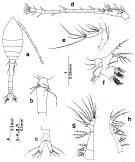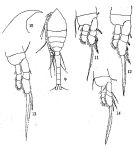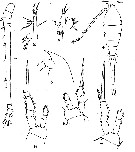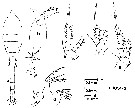|
|
 |
|
Cyclopoida ( Order ) |
|
|
|
Oithonidae ( Family ) |
|
|
|
Oithona ( Genus ) |
|
|
| |
Oithona vivida Farran, 1913 (F) | |
| | | | | | | Ref.: | | | Farran, 1913 a (p.183, figs.F); Rosendorn, 1917 a (p.32, figs.F); Kiefer, 1929 g (p.8, Rem.F); Sewell, 1948 (p.431, 461); Lindberg, 1955 a (p.465: Rem.); Wellershaus, 1970 (p.481); Kos, 1972 (Vol.I, figs.F, Rem.); Chen & al., 1974 (p.39, figs.F, p.75: Rem.); Nishida & al., 1977 (p.154, figs.F); Shuvalov, 1980 (p.130, figs.F); Ferrari & Bowman, 1980 (p.20: Rem.); Nishida, 1985 a (p.102, Redescr.F,figs.F, Rem.: p.135); Yoo & Lim, 1993 (p.91, 97, 98, Table 1); Chihara & Murano, 1997 (p.939, Pl.196: F); Bradford-Grieve & al., 1999 (p.886, 966, figs.F); Conway & al., 2003 (p.207, figs.F, Rem.); Vives & Shmeleva, 2010 (p.80, figs.F, Rem.) |  Issued from : S. Nishida in Bull. Ocean Res. Inst., Univ. Tokyo, 1985, No 20. [p.103, Fig.60]. Female: a, habitus (dorsal); b, thoracic segment 5 and genital segment (lateral left side); c, anal segment and caudal rami (dorsal); d, A1; e, A2; f, Mx1; g, Mx2; h, Mxp. Nota: Proportional lengths of urosome segments and caudal ramus 11:31:16:15:14:14.
|
 Issued from : S. Nishida in Bull. Ocean Res. Inst., Univ. Tokyo, 1985, No 20. [p.104, Fig.61]. Female: a, forehead (lateral); b, Md; c, Md (biting edge); d, P1; e, P2; f, P3; g, P4. Nota after Vives & Shmeleva (2010, p.80): Setal formula on outer margin (in first) and inner margin (in second) of exopod segments (from proximal to distal) of P1 to P4: P1: 1, 1, 3; 0, 1, 4. P2: 1, 1, 3; 1, 1, 5 P3: 1, 1, 2; 1, 1, 5. P4: 1, 1, 2; 1, 1, 5.
|
 Issued from : S. Nishida in Bull. Ocean Res. Inst., Univ. Tokyo, 1985, No 20. [p.106, Table 5]. Characteristics of P1-4, Md and Mx1 of female Oithona vivida reported by workers. Re = exopoal segment; Ri = endopod.
|
 issued from : Q.-c Chen & S.-z. Zhang & C.-s. Zhu in Studia Marina Sinica, 1974, 9. [Pl.5, Figs.9-14]. Female (from China Seas): 9, habitus (dorsal); 10, forehead (lateral); 11, P1; 12, P2; 13, P3; 14, P4.
|
 issued from : G.P. Farran in Proc. zool. Soc. Lond., 1913. [Plate XXVII, Figs.1-8]. Female (from Christmas Island, Indian): 1, A1; 2, Md (mandibular palp); 3, Mx1; 4, habitus (dorsal); 5, forehead (lateral); 6-8, P1 to P3.
|
 issued from : I. Rosendorn in Wiss. Ergebn. dt. Tiefsee-Exped. \"Valdiviella\", 1917, 23. [p.33, Fig.18]. Female: a, forehead; b, rostrum (aberant); c, cephalothorax (lateral); d, Md (mandibular palp); e, Mx1. Nota: Proportion of lengths (p.cent) Prosome : 52.17, Urosome : 47.83 . Relative lengths of urosomal segments and caudal rami: 7 : 18 : 10 : 9 : 8 : 7 . Setal formula of the exopod swimming legs P1 to P4 (Se = outer setae ; Si = inner setae), P1 : 1, 1, 3 Se ; 1, 1, 5 Si ; P2 : 1, 1, 3 Se ; 1, 1, 5 Si ; P3 : 1, 1, 2 Se ; 1, 1, 5 Si ; P4 : 1, 1, 3 Se ; 1, 1, 5 Si.
|
 issued from : V.S. Shuvalov in Opred. Faune SSSR, Nauka, Leningrad, 1980, 125. [p.131, Fig.32, 9-14]. Female: 9-10, prosome (dorsal and lateral, respectively); 11, forehead (lateral); 12, urosome (dorsal); 13, thoracic segment 5 and genital segment (dorsal); 14, anal segment and caudal rami.
|
 Issued from : S. Nishida, O. Tanaka & M. Omori in Bull. Plankton Soc. Japan, 1977, 24 (2). [p.154, Fig.16]. Female (off Suruga Bay and adjacent waters): a, habitus (dorsal); b, forehead (lateral); c, Md; Mx1; e, P2; f, P4; g, P4. Nota: Nota: Formulae of exopod P1 to P4 (outer setae in first, inner setae in second). P1: 1,1,3; 0,1,4. P2: 1,1,3; 1,1,5. P3: 1,1,2; 1,1,5. P4: 1,1,2; 1,1,5. Prosome length/urosome length = 0.92-1.06.
|
 Issued from : K.-I. Yoo & D.-H. Lim in The Korean J. Syst. Zool., 1993, 9 (2) [p.97: key of female] in Korean Waters: Morphological characters of Oithona vivida female :
1 - Anterior part of prosome produced into pointed rostrum in dorsal view.
2 - Exopod 3rd segment of P1 with 3 outer marginal spines. 3 - Exopod 3rd segment of P4 with 2 spines. 4 - Exopod 3rd segment of P3 with 2 setae.
| | | | | Compl. Ref.: | | | Wilson, 1942 a (p.197); Shmeleva, 1964 a (p.1068); Pavlova, 1966 (p.44); Delalo, 1968 (p.138); Kovalev & Shmeleva, 1982 (p.85); Dussart, 1984 (p.25, 64:Rem.): Yoo, 1991 (tab.1); Shih & Young, 1995 (p.75); Noda & al., 1998 (p.55, Table 3, occurrence); Hure & Krsinic, 1998 (p.103); Mazzocchi & al., 2005 (p.155); Zuo & al., 2006 (p.164: tab.1); Mazzocchi & Di Capua, 2010 (p.428); Hsiao S.H. & al., 2011 (p.475, Appendix I); Uysal & Shmeleva, 2012 (p.909, Table I); Tachibana & al., 2013 (p.545, Table 1, seasonal change 2006-2008); Lidvanov & al., 2013 (p.290, Table 2, % composition); Mazzocchi & al., 2014 (p.64, Table 5, abundance); Benedetti & al., 2016 (p.159, Table I, fig.1, functional characters); Benedetti & al., 2018 (p.1, Fig.2: ecological functional group) | | | | NZ: | 12 | | |
|
Distribution map of Oithona vivida by geographical zones
|
| | | | | | | | | | | |  Issued from : S. Nishida in Bull. Ocean Res. Inst., Univ. Tokyo, 1985, No 20. [p.135, Fig.85]. Issued from : S. Nishida in Bull. Ocean Res. Inst., Univ. Tokyo, 1985, No 20. [p.135, Fig.85].
Indo-Pacific geographical distribution of Oithona vivida. Dotted line: AC, Arctic Convergence; SC, Subtropical Convergence. |
| | | | Loc: | | | South Africa, off Angola, Morocco-Mauritania, off Amazon, off Cape Finisterre, Medit. (Alboran Sea, Ligurian Sea, G. of Napoli, N & S Adriatic Sea, Aegean Sea, Lebanon Basin), Red Sea, Indian, Christmas Is., China Seas (Yellow Sea, East China Sea, South China Sea), Taiwan (E: Kuroshio Current), S Korea (Cheju Is.), Japan, Kuchinoerabu Is., Tokyo Bay, Pacif. (tropical), California, off Panama, SE Pacif. | | | | N: | 31 | | | | Lg.: | | | (109) F: 0,74-0,68; (627) F: 0,83-0,69; (634) F: 0,74-0,68; (649) F:0,69; (880) F: 0,68-0,74; {F: 0,68-0,83} | | | | Rem.: | epiplagic.
According to Nishida (1985, p.105) the species is one of the most morphologically-variable species in the genus (See above Table 5, p.106).
After Benedetti & al. (2018, p.1, Fig.2) this species belonging to the functional group 6 corresponding to small ambush feeding omnivorous.
See in DVP Conway & al., 2003 (version 1) | | | Last update : 29/11/2019 | |
|
|
 Any use of this site for a publication will be mentioned with the following reference : Any use of this site for a publication will be mentioned with the following reference :
Razouls C., Desreumaux N., Kouwenberg J. and de Bovée F., 2005-2025. - Biodiversity of Marine Planktonic Copepods (morphology, geographical distribution and biological data). Sorbonne University, CNRS. Available at http://copepodes.obs-banyuls.fr/en [Accessed January 04, 2026] © copyright 2005-2025 Sorbonne University, CNRS
|
|
 |
 |












